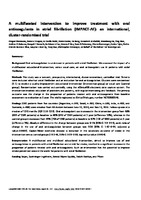Repositorio Digital
A multifaceted intervention to improve treatment with oral anticoagulants in atrial fibrillation (IMPACT-AF): an international, cluster-randomised trial
- DSpace Principal
- →
- Hospital El Cruce
- →
- Publicaciones
- →
- Artículos
- →
- Ver ítem
JavaScript is disabled for your browser. Some features of this site may not work without it.
A multifaceted intervention to improve treatment with oral anticoagulants in atrial fibrillation (IMPACT-AF): an international, cluster-randomised trial
Vinereanu, Dragos; Lopes, Renato; Bahit, Cecilia; Xavier, Denis; Jiang, Jie; Al-Khalidi, Hussein R; He, Wensheng; Xian, Ying; Ciobanu, Andrea O; Kamath, Deepak Y; Fox, Kathleen A; Rao, Meena P; Pokorney, Sean D; Berwanger, Otavio; Tajer, Carlos; de Barros e Silva, Pedro; Roettig, Mayme L; Huo, Yong; Granger, Christopher B; Carbajales, Justo; Gómez, Javier Neri Ceferino; Principato, Mario Bruno; Von Wulffen, María Alejandra; Acunzo, Jorge Galperín Rafael Salvador; Bonato, Ricardo Renato; Ciampi, Natalia; Marani, Alberto Babil; Panigadi, Cristian Gustavo; Pastura, Silvia Gabriela; Onetto, Leonardo Martín; IMPACT-AF investigators
Fecha:
2017
Resumen:
BACKGROUND: Oral anticoagulation is underused in patients with atrial fibrillation. We assessed the impact of a multifaceted educational intervention, versus usual care, on oral anticoagulant use in patients with atrial fibrillation.
METHODS: This study was a two-arm, prospective, international, cluster-randomised, controlled trial. Patients were included who had atrial fibrillation and an indication for oral anticoagulation. Clusters were randomised (1:1) to receive a quality improvement educational intervention (intervention group) or usual care (control group). Randomisation was carried out centrally, using the eClinicalOS electronic data capture system. The intervention involved education of providers and patients, with regular monitoring and feedback. The primary outcome was the change in the proportion of patients treated with oral anticoagulants from baseline assessment to evaluation at 1 year. The trial is registered at ClinicalTrials.gov, number NCT02082548.
FINDINGS: 2281 patients from five countries (Argentina, n=343; Brazil, n=360; China, n=586; India, n=493; and Romania, n=499) were enrolled from 48 clusters between June 11, 2014, and Nov 13, 2016. Follow-up was at a median of 12·0 months (IQR 11·8-12·2). Oral anticoagulant use increased in the intervention group from 68% (804 of 1184 patients) at baseline to 80% (943 of 1184 patients) at 1 year (difference 12%), whereas in the control group it increased from 64% (703 of 1092 patients) at baseline to 67% (732 of 1092 patients) at 1 year (difference 3%). Absolute difference in the change between groups was 9·1% (95% CI 3·8-14·4); odds ratio of change in the use of oral anticoagulation between groups was 3·28 (95% CI 1·67-6·44; adjusted p value=0·0002). Kaplan-Meier estimates showed a reduction in the secondary outcome of stroke in the intervention versus control groups (HR 0·48, 95% CI 0·23-0·99; log-rank p value=0·0434).
INTERPRETATION: A multifaceted and multilevel educational intervention, aimed to improve use of oral anticoagulation in patients with atrial fibrillation and at risk for stroke, resulted in a significant increase in the proportion of patients treated with oral anticoagulants. Such an intervention has the potential to improve stroke prevention around the world for patients with atrial fibrillation.
Descripción:
Fil: Tajer, C. Hospital de Alta Complejidad en Red El Cruce Dr. Néstor C. Kirchner. Servicio de Cardiología. Florencio Varela, Argentina.
Ficheros en el ítem
Este ítem aparece en la(s) siguiente(s) colección(ones)
-
Artículos
Articles
Buscar
Listar
-
Todo DSpace
-
Esta colección

